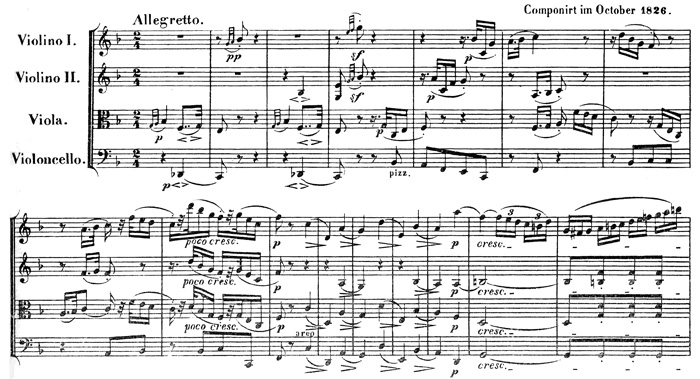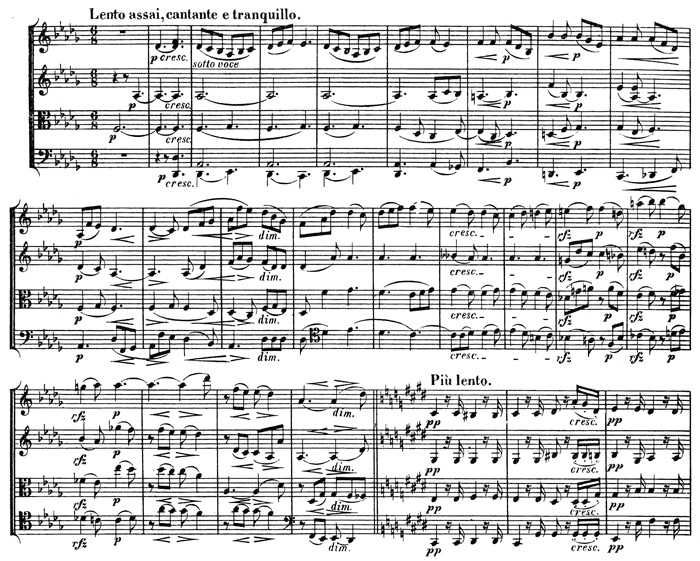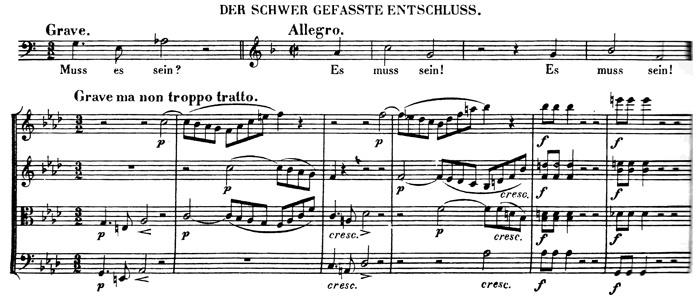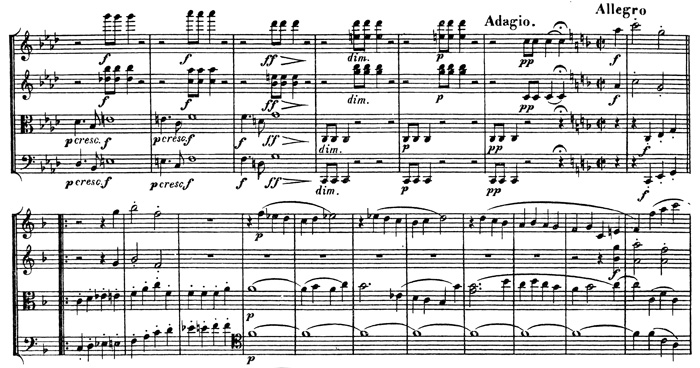Ludwig van Beethoven
String Quartet in F major, op.135
Media Review / Comparison
2013-02-15 — Original posting (on Blogger)
2013-08-07 — New standard layout applied
2013-10-25 — 2012 Hagen Quartett recording added, minor adjustments
2014-11-07 — Re-posting as is (WordPress)
2016-07-11 — Brushed up for better readability
Table of Contents
- Introduction / The Recordings
- The Composition
- Timing Comparison
- Comments on the Individual Recordings
- Endellion String Quartet (2005)
- Amadeus Quartet (1963)
- Guarneri String Quartet (1969)
- Emerson String Quartet (1997)
- Busch Quartett (1935)
- LaSalle Quartet (1976)
- Quartetto Italiano (1968)
- Leipziger Streichquartett (1998)
- Takács Quartet (2004)
- Alban Berg Quartett (1982)
- Melos Quartett Stuttgart (1984)
- Artemis Quartet (2011)
- Hagen Quartett (1990)
- Hagen Quartett (2012)
- Addendum
Introduction / The Recordings
Here’s another note on the recordings of Beethoven’s string quartets in my music collection, about the quartet in F major, op.135 — references to the CDs are given at the bottom of the respective section, or in one of the related postings, or see the summary on the postings covering Beethoven’s String Quartets. Here’s a short list of the recordings in this comparison, in alphabetic order:
- Alban Berg Quartett (1982)
- Amadeus Quartet (1963)
- Artemis Quartet (2011)
- Busch Quartet (1935)
- Emerson String Quartet (1997)
- Endellion String Quartet (2005)
- Guarneri String Quartet (1969)
- Hagen Quartett (1990)
- Hagen Quartett (2012)
- LaSalle Quartet (1976)
- Leipziger Streichquartett (1998)
- Melos Quartett (1984)
- Quartetto Italiano (1968)
- Takács Quartet (2004)
The Composition
The String Quartet in F major, op.135 by Ludwig van Beethoven (1770 – 1827) features the following movements:
1. Allegretto (2/4)
There seems to be a general consensus among the artists to play this movement between 1/4 = 56 up to 1/4 = 68 — which is slow for an Allegretto in 2/4 notation — though large parts of the movement are in semiquavers and semiquaver trioles, so one should read this in quavers, i.e., like 4/8 in the “busy” parts. The movement is a moody piece, with many general breaks — the musical flow being one of the challenges, especially with slower interpretations.
An interesting detail is shown in the last example above: in bars 112/113 and 116/117 there are clear allusions (marked in yellow) to the Great Fugue op.133!
2. Vivace (3/4)
A short, fast, virtuoso, rhythmically intricate, Scherzo-type movement with a structure AABAA; the main challenge here is rhythmic clarity, transparency — and definitely, “post-charging” on syncopated notes is detrimental in this piece!
3. Lento assai, cantante e tranquillo (6/8) — Più lento (6/8)
One of the very, very few movements in Beethoven’s oeuvre with the notation “Lento” — actually Lento assai, cantante e tranquillo, loosely translated to “pretty slow, singing and calm”, and the middle part (C♯ minor) even reads Più lento — i.e., even slower: very exceptional, as is the main tonality of the movement: D♭ major — rather unusual for string instruments!
The Busch Quartett takes the Lento to its extreme, extending the movement to over 10 minutes. I doubt that this was Beethoven’s intent: after all, there is also cantante, i.e., “singing” — and at such a slow tempo not only any hypothetical singer would run out of breath, but also the listener has forgotten the beginning of the melody before the theme is over! But even in the interpretation by the Busch Quartett this is a very touching, moving composition. One should keep in mind that with 6/8 notation, the counting units should be 3/8, not 1/8!
4. Der schwer gefasste Entschluss: Grave, ma non troppo tratto (3/2) — Allegro (2/2, alla breve)
Difficult to Understand?
A strange and difficult-to-understand movement! Really?? Beethoven gives two short motifs as guide: “Muss es sein?” (Grave), i.e., “Must it be?”, and “Es muss sein! – Es muss sein!” (Allegro), i.e., “It must be! — It must be!”; these are not themes, really, just motifs, short fragments. These two motifs are associated with respective sections: the movement starts with a Grave section associated with the “question motif”.
This section really does not need explaining; in the second half there are “exclamatory dissonances”, indicating growing anxiety, or rather anger — then, after a fermata, the “answer”, an Allegro, starts, almost joyful, whereby the “answer motif” is indeed associated with a melody-like theme (19 bars), followed by an ending phrase (12 bars) — the following, second theme is in A major and evolves from the melody of the first theme. That section (60 bars total) is repeated (without the initial Grave section), making this look like the exposition of a sonata movement. The exposition is easy to understand, even though it does of course use Beethoven’s “advanced language” typical of his late string quartets.
A Sonata Movement?
Also the following “development part” (79 bars) is not all that unusual, though in the end it does take some interesting turns in the tonality — then, one expects a recapitulation part: there is another Grave ma non troppo tratto segment (13 bars), but this now is clearly not a recapitulation, as the “question” theme is accompanied by very loud (ff) ostinato dissonances that gradually calm down towards the end of that section.
In the following 61 bars, the themes from the exposition return — sort of: again, this is not the usual repetition of the exposition in altered tonality; the artists appear to start on a theme, but then things appear to run out of control: the harmonies move into weird areas, each of the artists seems to follow their own score, or play different pieces altogether? Sometimes the movement seems to divert into total chaos, or one gets the impression of an orchestra rehearsing before the conductor turns up. So, this really isn’t a sonata movement.
Repeats?
The second part can be repeated — Beethoven writes “Si repete la seconda parte al suo piacere” (which I would freely translate with “You may repeat this as you like — if you dare!“). In this comparison, only two ensembles (Endellion String Quartet and Leipziger Streichquartett) do that second repetition. After all that chaos, the artists seem totally lost, insecure — and all of a sudden, the piece ends with a lovely, playful melody with pizzicato accompaniment, serene and harmless, as if it were a piece by Haydn.
At this point it should be clear: Beethoven is joking! It may be a grim joke, after all, maybe sarcastic — but I have no doubt about this: stop analyzing the harmonies in the second part, and have fun with the surprises of that joke! It may sound strange that Beethoven does this in the last, full composition in his career — but somehow this reminds me of a famous quote: “Tutto nel mondo è burla, l’uom è nato burlone“…
Timing Comparison
As one of the few things that one can actually “measure” in music performances, I’m giving the approximate metronome numbers for each of the movements in the text below. As these numbers are spread over the text, I felt it would help if I collected them in a table, shown below. I have used color coding to indicate relative rates: white would be the average tempo, blue fields are slower tempi, green indicates faster-than-average performances (where the strength of the color indicates the amount of deviation from the average). Some ensembles prefer slower tempi, others are faster throughout, some are “mixed bags” (click on table for full size view):
Comments on the Individual Recordings
The order of the interpretations is not chronological (neither by recording / publishing date nor by purchase date), but follows my personal, subjective rating, my preferred recording shown last:
Endellion String Quartet (2005)
Beethoven: Complete String Quartets, Quintets & Fragments
WCJ (Warner Classics & Jazz) 2564 69471-3 (stereo, 10 CD); ℗ / © 2008


Recorded in 2007, with Andrew Watkinson, Ralph de Souza, Garfield Jackson, and David Waterman — for general comments see op.131.
Notes on the Movements
1. Allegretto (2/4)
6’24”; 1/4 = 66
Too much vibrato, sometimes marginal intonation; a number of very strange hold-ups disrupt the flow — and the articulation is sometimes superficial. Not very convincing, overall.
2. Vivace (3/4)
3’17”; 1/4 = 122
Rhythmically not always clear & accurate, articulation and intonation are often superficial.
3. Lento assai, cantante e tranquillo (6/8) — Più lento (6/8)
7’50”; 1/8 = 41 (Lento assai, cantante e tranquillo) — 1/8 = 40 (Più lento)
Too slow (played in eighths rather than 3/8), and the vibrato is too heavy, the amplitude too big and affecting the intonation. Then, the Più lento isn’t really slower (how could it be, at this base tempo?), totally static / without evolution, flow.
4. Der schwer gefasste Entschluss: Grave, ma non troppo tratto (3/2) — Allegro (2/2, alla breve)
9’25”; 1/2 = 36 (Grave, ma non troppo tratto) — 1/2 = 156 (Allegro)
Too much vibrato, affecting the intonation; articulation, coordination and tone are superficial — maybe the tempo is too fast for this ensemble? There are also some tempo control issues, and some strange tempo relations. On the positive side: this is one of only two ensembles in this comparison performing the second repetition.
| Recommendation: | No! |
| Rating: | 2.0 (2 / 2 / 2 / 2) |
Amadeus Quartet (1963)
Beethoven: The String Quartets (opp. 18, 59, 74, 95, 127, 130-133, 135)
DG 463 143-2 (stereo, 7 CD); ℗ 1962 / © 1974

Recorded in 1963, with Norbert Brainin, Siegmund Nissel, Peter Schidlof, Martin Lovett — for general comments see op.18/1.
Notes on the Movements
1. Allegretto (2/4)
6’46”; 1/4 = 61
Lacks subtlety in articulation and tone, limited dynamics, the first violin is dominating too much; some odd ritardandi, causing disruptions in the musical flow (which is tricky anyway in this movement).
2. Vivace (3/4)
3’26”; 1/4 = 114
Superficial in the articulation (especially in the quavers), rough & coarse; the worst part of this interpretation is their “post-charging” on all syncopes — which totally destroys the effect that these should produce!
3. Lento assai, cantante e tranquillo (6/8) — Più lento (6/8)
8’14”; 1/8 = 49 (Lento assai, cantante e tranquillo) — 1/8 = 34 (Più lento)
The first violin is too strong & coarse (and with too much vibrato) — this destroys the mood in this movement. The Tempo I section is schematic, lacking flow.
4. Der schwer gefasste Entschluss: Grave, ma non troppo tratto (3/2) — Allegro (2/2, alla breve)
7’03”; 1/2 = 43 (Grave, ma non troppo tratto) — 1/2 = 132 (Allegro)
The “question” part appears rather fast (it is indeed the fastest in this comparison), the articulation overall is straight, rough, “square” (“rectangular”, if you want); I don’t think the artists understand this movement as a joke — in their hands, the second part is turned into a “modernist” piece, maybe Second Vienna School?
| Recommendation: | No |
| Rating: | 2.2 (3 / 1 / 2 / 3) |
Guarneri String Quartet (1969)
Beethoven: The Late String Quartets, opp. 127, 130-133, 135
RCA Victor / BMG Classics 60458-2-RG (stereo, 3 CD); ℗ / © 1990

Recorded in 1969, with Arnold Steinhardt, John Dalley, Michael Tree, David Soyer — for general comments see op.127.
Notes on the Movements
1. Allegretto (2/4)
7’02”; 1/4 = 56
I hate that heavy, sometimes even synchronous vibrato. The intonation is sometimes marginal, the flow often broken — I would not say they master the slow tempo that they selected!
2. Vivace (3/4)
3’17”; 1/4 = 122
Very good in articulation and rhythm — one of the best movements for this ensemble in this series! Very good, except for some minor intonation issues due to their vibrato.
3. Lento assai, cantante e tranquillo (6/8) — Più lento (6/8)
8’46”; 1/8 = 50 (Lento assai, cantante e tranquillo) — 1/8 = 27 (Più lento)
A good tempo in the outer parts, though the intonation is sometimes marginal (especially in the Tempo I part, the vibrato affects the tonal purity). Unfortunately, the Più lento is way too slow (I don’t think that annotation can possibly mean “half the tempo”) — the flow stops completely. The only possible argument for halving the tempo that I can think of is that the Più lento part ends with two semiquavers, and this way, these can be taken at the value of the following quaver figures — but this is hardly a valid argument, as the other artists find good solutions for this transition without using such an extreme tempo relationship.
4. Der schwer gefasste Entschluss: Grave, ma non troppo tratto (3/2) — Allegro (2/2, alla breve)
7’24”; 1/2 = 35 (Grave, ma non troppo tratto) — 1/2 = 142 (Allegro)
Very strong vibrato throughout. The “question” part to me is too legato, not really “speaking”. The intonation is marginal (to be expected with such vibrato), the articulation not always accurate, consequent or adequate (the “answer” in German reads “Es muss sein”, not “Es muuhs sein”), some staccati are simply ignored.
| Recommendation: | No |
| Rating: | 2.8 (2 / 4 / 3 / 2) |
Emerson String Quartet (1997)
Beethoven: The String Quartets (opp. 18, 59, 74, 95, 127, 130-133, 135)
DG 447 075-2 (stereo, 7 CD); ℗ 1996

Recorded in 1997, with Eugene Drucker, Philip Setzer, Lawrence Dutton, David Finckel — for general comments see op.18/1.
Notes on the Movements
1. Allegretto (2/4)
6’20”; 1/4 = 67
Vibrato and articulation are overblown (with bulge notes, some “celebrated” sections), affecting the intonation.
2. Vivace (3/4)
3’01”; 1/4 = 132
Definitely too fast: at this tempo, the syncopes lose their effect, the listener can’t follow the rhythmic “jokes” in this piece — the fast notes sound superficial (even though they may well be played accurately); this interpretation lacks the playful and scherzo aspects of the movement. I still give them a high rating for the speed record / their technical achievement in this movement, even though the listening pleasure is limited!
3. Lento assai, cantante e tranquillo (6/8) — Più lento (6/8)
6’49”; 1/8 = 56 (Lento assai, cantante e tranquillo) — 1/8 = 41 (Più lento)
Excess vibrato (some really extreme), portamenti, overblown in general, and some of the same bad articulation as with the Artemis Quartet in that same movement.
4. Der schwer gefasste Entschluss: Grave, ma non troppo tratto (3/2) — Allegro (2/2, alla breve)
6’21”; 1/2 = 38 (Grave, ma non troppo tratto) — 1/2 = 160 (Allegro)
Very strong and fast vibrato — consequently, the intonation is not clean. The articulation is often soft, “spongy”.
| Recommendation: | Maybe for the second movement, but not otherwise. |
| Rating: | 3.2 (3 / 4 / 3 / 3) |
Busch Quartett (1935)
Beethoven: The Late Quartets opp.95, 127, 130, 131, 132, 133, 135
Pearl, Pavilion Records Ltd., GEMS 0053 (3 CDs); ℗ 1999

Recorded in 1935, with Adolf Busch, Gösta Andreasson, Karl Doktor, Hermann Busch — for general comments see op.95.
Notes on the Movements
1. Allegretto (2/4)
6’49”; 1/4 = 60
Careful, conscious phrasing, articulation and agogics (no rubato, though), no problem with the musical flow & the big phrases, pretty limited vibrato overall. The first violin is sometimes a bit too dominant — this can also be a limitation of the recording technique (the tone is very good for the age of the recording, though!).
2. Vivace (3/4)
3’15”; 1/4 = 120
Some intonation issues (vibrato?), fast, virtuosic, though sometimes at the limit to harsh articulation; still very good overall, dramatic, expressive.
3. Lento assai, cantante e tranquillo (6/8) — Più lento (6/8)
10’19”; 1/8 = 31 (Lento assai, cantante e tranquillo) — 1/8 = 29 (Più lento)
This is so slow that it rather reminds me of the Adagietto from Gustav Mahler’s fifth symphony — composed 75 years after this string quartet (maybe in 1901 Mahler was thinking of this string quartet?); that comment may be a bit far-fetched — but this movement is definitely much too slow, and not really Beethoven (I think): after all, the annotation states cantante — singing — and at this tempo, the melody is impossible to sing (a single bar lasts almost 12 seconds!) — plus, when reaching the middle of the melody, the listener has forgotten its beginning! That said: even at this tempo, this interpretation is a very impressive, touching piece of music.
4. Der schwer gefasste Entschluss: Grave, ma non troppo tratto (3/2) — Allegro (2/2, alla breve)
7’02”; 1/2 = 37 (Grave, ma non troppo tratto) — 1/2 = 136 (Allegro)
The “question” part is expressive, the “answer” part emotional, with a slight flavor of a (grim) joke; the second Grave part isn’t really “heavy”, but substantially faster than the introduction.
| Recommendation: | An impressive performance overall, especially considering its age! |
| Rating: | 3.5 (4 / 3 / 3 / 4) |
LaSalle Quartet (1976)
Beethoven: The Late String Quartets (opp. 127, 130, 131, 132, 133, 135)
Brilliant Classics 94064 (3 CDs); ℗ / © 1997 (Deutsche Grammophon)

Recorded in 1976, with Walter Levin, Henry W. Meyer, Peter Kamnitzer, Jack Kirstein — for general comments see op.127.
Notes on the Movements
1. Allegretto (2/4)
6’35”; 1/4 = 62
Very heavy, strong vibrato, affecting the intonation; often coarse in articulation and tone — the musical flow is OK, though.
2. Vivace (3/4)
3’30”; 1/4 = 114
Articulation and intonation are rough, coarse.
3. Lento assai, cantante e tranquillo (6/8) — Più lento (6/8)
7’24”; 1/8 = 49 (Lento assai, cantante e tranquillo) — 1/8 = 35 (Più lento)
Overblown, with heavy vibrato, frequent bulge notes; in the Tempo I part, the lower voices should be given a bit more presence.
4. Der schwer gefasste Entschluss: Grave, ma non troppo tratto (3/2) — Allegro (2/2, alla breve)
7’00”; 1/2 = 32 (Grave, ma non troppo tratto) — 1/2 = 144 (Allegro)
Very strong and nervous vibrato, but with accurate dynamics, expressive — on the other hand, some of the articulation appears arbitrary.
| Recommendation: | No (except maybe for the last movement) |
| Rating: | 3.0 (3 / 2 / 3 / 4) |
Quartetto Italiano (1968)
Beethoven: Complete String Quartets (opp. 18, 59, 74, 95, 127, 130-133, 135)
Decca 454 062-2 (stereo, 10 CD); ℗ 1972 / © 1996

Recorded in 1968, with Paolo Borciani, Elisa Pegreffi, Piero Farulli, Franco Rossi — for general comments see op.18/1.
Notes on the Movements
1. Allegretto (2/4)
6’23”; 1/4 = 66
Very expressive — but with some rather strong vibrato (even a certain tendency to synchronize the vibrato), affecting the intonation; moreover, some strange agogics / tempo changes.
2. Vivace (3/4)
4’05”; 1/4 = 102
The slowest version in this comparison, rather heavy for a Vivace, minor inaccuracies in the articulation.
3. Lento assai, cantante e tranquillo (6/8) — Più lento (6/8)
7’13”; 1/8 = 49 (Lento assai, cantante e tranquillo) — 1/8 = 38 (Più lento)
I like their warm tone, their ensemble playing! The Tempo I part could be more transparent (the first violin dominates too much).
4. Der schwer gefasste Entschluss: Grave, ma non troppo tratto (3/2) — Allegro (2/2, alla breve)
7’42”; 1/2 = 27 (Grave, ma non troppo tratto) — 1/2 = 144 (Allegro)
The “question” part is very serious, very heavy (doesn’t fit the “non troppo tratto“), with lots of vibrato; in the “answer” part, the articulation is not 100% accurate, there are some tempo instabilities, the interpretation is heavy, not really Allegro (= joyful!).
| Recommendation: | No, unless you are a fan of these artists |
| Rating: | 3.0 (3 / 3 / 3 / 3) |
Leipziger Streichquartett (1998)
Beethoven: String Quartets opp. 131 & 135
Musikproduktion Dabringhaus und Grimm, MDG 307 0820-2 (CD, stereo); ℗ / © 1998

Recorded in 1998, with Andreas Seidel, Tilman Büning, Ivo Bauer, Matthias Moosdorf — for general comments see op.131.
Notes on the Movements
1. Allegretto (2/4)
6’36”; 1/4 = 62
Compared to other, recent recordings, the tone appears rather dull — plus, the level of reverberation is at the limit of being irritating. The vibrato is rather strong, and they have a tendency to play bulge notes.
2. Vivace (3/4)
3’22”; 1/4 = 118
The reverberation and the rather soft articulation affect the rhythmic transparency; the softness also diminishes the “scherzo effect”; Also, their tempo concept is rather strange: I can’t see why the central ff / ostinato section should be played substantially faster than the rest of the movement!
3. Lento assai, cantante e tranquillo (6/8) — Più lento (6/8)
8’38”; 1/8 = 42 (Lento assai, cantante e tranquillo) — 1/8 = 31 (Più lento)
Too much vibrato, too slow for cantante (played in eighths rather than 3/8); the Più lento is way too slow and static, and in the last part (Tempo I), the ornaments are mistaken for melody.
4. Der schwer gefasste Entschluss: Grave, ma non troppo tratto (3/2) — Allegro (2/2, alla breve)
10’44”; 1/2 = 34 (Grave, ma non troppo tratto) — 1/2 = 144 (Allegro)
I don’t see why ff automatically should translate to “lots of vibrato“; also, there is a tendency towards bulge notes. On the positive side: this is one of only two ensembles (in this comparison) performing the second repetition, so one gets to enjoy more of the joke / irony aspect of the movement!
| Recommendation: | I like their last movement overall, but the other movements don’t really stand out. |
| Rating: | 3.0 (3 / 3 / 2 / 4) |
Takács Quartet (2004)
Beethoven: The Late String Quartets (opp. 95, 127, 130 – 133, 135)
Decca 470 849-2 (stereo, 3 CD); ℗ / © 2004

Recorded in 2004, with Edward Dusinberre, Károly Schranz, Roger Tapping, András Fejér — for general comments see op.95.
Notes on the Movements
1. Allegretto (2/4)
6’15”; 1/4 = 68
This could be a pretty good interpretation in concept, phrasing and expression — unfortunately, as with many traditional interpretations, they use a very heavy vibrato (especially in the first violin), making it hard to listen to this recording! On top of that, their articulation is rather soft.
2. Vivace (3/4)
3’19”; 1/4 = 122
Sonorous, expressive, but with noticeable “post-charging” on syncopes (especially in the lower voices), articulation and intonation are “so – so”…
3. Lento assai, cantante e tranquillo (6/8) — Più lento (6/8)
7’52”; 1/8 = 42 (Lento assai, cantante e tranquillo) — 1/8 = 38 (Più lento)
Pale, desperate — very slow for cantante (played in eighths rather than 3/8); the vibrato is strong, but probably acceptable. The musical flow is OK, even though the melody is not singable (except maybe for short phrases). Also the Più lento is mostly fine, but with some fairly heavy vibrato, especially on shorter notes. The vibrato hurts even more in the Tempo I part, where they also make the mistake of taking ornaments for the melody.
4. Der schwer gefasste Entschluss: Grave, ma non troppo tratto (3/2) — Allegro (2/2, alla breve)
7’19”; 1/2 = 27 (Grave, ma non troppo tratto) — 1/2 = 150 (Allegro)
Extreme vibrato, affecting the intonation — but at least they expose the sharp dissonances. Wide dynamics — unfortunately, nice melodies tend to get an extra portion of vibrato — this does not help! Where is the joking aspect of this piece?
| Recommendation: | With less vibrato, they would earn a substantially better rating! |
| Rating: | 3.0 (3 / 3 / 3 / 3) |
Alban Berg Quartett (1982)
Beethoven: The Late String Quartets (opp. 127, 130-133, 135)
EMI CDS 7 47135 8 (stereo, 4 CD); ℗ 1982 – 1984

Recorded in 1982, with Günther Pichler, Gerhard Schulz, Thomas Kakuska, Valentin Erben — for general comment see op.127.
Notes on the Movements
1. Allegretto (2/4)
6’19”; 1/4 = 66
Technically these artists don’t have any problem here — but the use a very heavy vibrato everywhere, making the intonation unclear. Exaggerated dynamics, as often with these artists; static / schematic in articulation and phrasing.
2. Vivace (3/4)
3’27”; 1/4 = 114
Virtuosic, detailed, clear, very good in the syncopes, rhythmically excellent in general — just some strong vibrato, occasionally.
3. Lento assai, cantante e tranquillo (6/8) — Più lento (6/8)
7’49”; 1/8 = 49 (Lento assai, cantante e tranquillo) — 1/8 = 33 (Più lento)
A lot of vibrato — but the musical flow is OK;, good, accurate dynamics; in the Tempo I part, the first violin is too dominant.
4. Der schwer gefasste Entschluss: Grave, ma non troppo tratto (3/2) — Allegro (2/2, alla breve)
6’53”; 1/2 = 35 (Grave, ma non troppo tratto) — 1/2 = 156 (Allegro)
Accurate dynamics, articulation and phrasing, technically excellent, exposing the irony in this piece — if only they used a little less vibrato!
| Recommendation: | One of their best interpretations among the late Beethoven Quartets: an excellent traditional (non-HIP) performance, overall. |
| Rating: | 3.8 (3 / 4 / 4 / 4) |
Melos Quartett Stuttgart (1984)
Beethoven: Die späten Streichquartette, opp.127, 130-133, 135
DG 415 676-1 (stereo, 3 CD); ℗ 1986

Recorded in 1984, with Wilhelm Melcher, Gerhard Voss, Hermann Voss, Peter Buck — for general comments see op.127.
Notes on the Movements
1. Allegretto (2/4)
6’12”; 1/4 = 68
Very dramatic — a well-formed, expressive interpretation with good phrasing; my main criticism here is (once more) the vibrato — though it does not hurt as much here as it does with other ensembles.
2. Vivace (3/4)
3’17”; 1/4 = 120
There is some “post-charging” of syncopes — but mainly in the crescendo sections. Their articulation is rather broad (often close to legato), and not always quite accurate (also due to the vibrato?); dramatic, expressive, but not the best in transparency.
3. Lento assai, cantante e tranquillo (6/8) — Più lento (6/8)
6’43”; 1/8 = 49 (Lento assai, cantante e tranquillo) — 1/8 = 41 (Più lento)
Very expressive, even dramatic, and in the Tempo I part, one can nicely follow the dialog between the two violins — if they just weren’t using that much vibrato!
4. Der schwer gefasste Entschluss: Grave, ma non troppo tratto (3/2) — Allegro (2/2, alla breve)
6’46”; 1/2 = 32 (Grave, ma non troppo tratto) — 1/2 = 142 (Allegro)
Expressive, very good! Sonorous, emotional, with distinct agogics, exposing the joke, the irony in this piece; the vibrato doesn’t really hurt here. They seem to emphasize the harmonic aspects of the movement, rather than overexposing the sharp dissonances.
| Recommendation: | I like their last movement — for the rest: too much vibrato… |
| Rating: | 4.0 (4 / 3 / 4 / 5) |
Artemis Quartet (2011)
Beethoven: String Quartets opp. 18/3, 18/5, 135
Virgin Classics 50999 070834 2 6 (stereo); ℗ / © 2011

Recorded in 2011, with Natalia Prischepenko, Gregor Sigl, Friedemann Weigele, Eckart Runge — for general comments see op.18/3.
Notes on the Movements
1. Allegretto (2/4)
6’25”; 1/4 = 65
Excellent — very careful, detailed articulation and phrasing, also working out the big developments in this movement, conscious use of agogics, very good coordination — technically absolutely superb; the one reservation that I have here: the vibrato is at the upper limit. Also, upon re-listening (and comparing to the newer recording by the Hagen Quartett), some of the agogics (to me) appear somewhat arbitrary, too much “consciously made”, rather than being driven by the musical flow.
2. Vivace (3/4)
3’20”; 1/4 = 120
Percussive (I like their accented syncopes!), engaged, alert, vibrating, vivid, lively, dramatic, “leaning forward”, with tension, accurate & transparent — simply excellent, impressive!
3. Lento assai, cantante e tranquillo (6/8) — Più lento (6/8)
6’29”; 1/8 = 50 (Lento assai, cantante e tranquillo) — 1/8 = 46 (Più lento)
The slurs in the main theme are interpreted as phrasing instructions, actually played détaché — that’s probably debatable: as this is one of the faster versions, I don’t see a compelling reason not to play legato, which I think would also be more adequate for a voice that is meant to imitate singing. The interpretation is expressive, emotional: playing détaché means the artists can use more bow, and hence a larger dynamic range.
In the Più lento part, there’s too much vibrato in the dramatic passages. What I definitely don’t like about this interpretation are several instances (especially in the Tempo I part) where they link long notes with a very short crescendo on the first note, and the next note receives a short accent — this sounds like “booooooooAbooo…”: I consider this a pretty bad habit (a typical student’s error? but these artists are experienced professionals!), or at least serious mannerism.
4. Der schwer gefasste Entschluss: Grave, ma non troppo tratto (3/2) — Allegro (2/2, alla breve)
7’08”; 1/2 = 28 (Grave, ma non troppo tratto) — 1/2 = 152 (Allegro)
An intellectual interpretation — and not their best one: they do (correctly) understand this movement as musical joke — but then they try to enhance the joke by adding extra agogics, articulation, etc., and to me this backfires on them. One cannot enhance this movement, as little as one can explain a joke: this just destroys the effect. They should let Beethoven’s music speak for itself; after all, the composer was really meticulous about making his notation extremely detailed, specific, accurate and complete.
| Recommendation: | Two good movements which I can certainly recommend listening to, but the last two are not their best interpretations, I think. |
| Rating: | 4.2 (4 / 5 / 4 / 4) |
Hagen Quartett (1990)
Schubert: String Quartet D.810 “Death and the Maiden”
Beethoven: String Quartet op.135
DG 431 814-2 (CD, stereo); ℗ 1992; barcode 028943181426

Recorded in 1990, with Lukas Hagen, Rainer Schmidt, Veronika Hagen, Clemens Hagen — for general comments on the ensemble see op.127; this is the oldest recording with these artists in this series (the ensemble was founded in 1981).
Notes on the Movements
1. Allegretto (2/4)
7’13”; 1/4 = 56
The Hagens use a relatively slow tempo, creating the impression of a desperate, forlorn, lonely soul / mood; an outstanding interpretation,. showing four artists playing together rather than against each other, with accurate & detailed articulation.
2. Vivace (3/4)
3’15”; 1/4 = 124
Excellent — playful, light, very good articulation, phrasing & dynamics, focusing more on the big evolution than on small phrases, fast, expressive, with accurate syncopes (no post-charging!); I particularly like their transitions in this piece!
3. Lento assai, cantante e tranquillo (6/8) — Più lento (6/8)
8’00”; 1/8 = 51 (Lento assai, cantante e tranquillo) — 1/8 = 33 (Più lento)
Excellent, very well balanced, with little vibrato! The Più lento part is fairly slow (compared to the surrounding Lento assai), but still very expressive and moving forward. The final Tempo I part is played with (some) vibrato, but still very linear and intimate, not overblown.
4. Der schwer gefasste Entschluss: Grave, ma non troppo tratto (3/2) — Allegro (2/2, alla breve)
7’34”; 1/2 = 29 (Grave, ma non troppo tratto) — 1/2 = 142 (Allegro)
Consequent, careful articulation in all voices, clear, “pure” dissonances, playful, ironic / joking (very nice: how the voices get “lost” before the Coda starts!). Excellent!
| Recommendation: | Yes, definitely — but check their newer recording: it’s even better! |
| Rating: | 5.0 (5 / 5 / 5 / 5) |
Hagen Quartett (2012)
Beethoven: String Quartets opp. 18/3, 18/5, 135
Myrios Classics MYR009 (SACD: 5-channel surround / stereo); ℗ 2012 / © 2013

On the Recording
Recorded in 2012, with Lukas Hagen, Rainer Schmidt, Veronika Hagen, Clemens Hagen — for general comments on the ensemble see op.127; this is the most recent recording with these artists in this series. This was added after the initial posting — I only did a restricted comparison (mostly just with the Melos Quartett and Artemis Quartet recordings, plus of course with the earlier recording by the Hagen Quartett above). Some general remarks first: obviously, just from the sound technique, one can hear the 22 years between this and the earlier recording by the same artists — this newer one (5-channel surround sound aside) offers more clarity, is more transparent and “spacious” than the earlier one.
Then, there are of course also differences in the interpretation & performance — though these are not that dramatic. Still, I sense that in the newer recording the artists have freed themselves from the need to prove their technical abilities by exhibiting technical perfection in articulation, intonation and coordination — based on a sound technical foundation, they can now fully focus on expression, the interpretation overall is more conclusive, compelling that the earlier one, but also in some ways more radical. The sound setting is more “analytical”, focusing on transparency rather than on a warm, uniform ensemble tone, as with some other (especially older) recordings.
Notes on the Movements
1. Allegretto (2/4)
7’30”; 1/4 = 55
Compared to the Artemis Quartet, this recording exhibits vastly more (and more mid-scale) agogics, it is more “narrative”, less “intellectual / academic, feels more natural and more dramatic and detailed in the articulation of the motifs in this movement. They use very little vibrato, but some distinctly positioned (but not obtrusive) portamenti.
2. Vivace (3/4)
3’35”; 1/4 = 118
Slower than the earlier recording (less “sportive”, more relaxed, not pushing for speed), but vastly more transparent, more careful and differentiated / detailed in the articulation, talking in the motifs, with overall focus on expression, not perfection in the sound.
3. Lento assai, cantante e tranquillo (6/8) — Più lento (6/8)
7’29”; 1/8 = 56 (Lento assai, cantante e tranquillo) — 1/8 = 34 (Più lento)
In the Lento assai part, the earlier recording certainly wasn’t on the slow side — this now is faster, as fast as the Emerson String Quartet — but correctly played 3/8 + 3/8, i.e., in half-bars, focusing on the cantante (singing) aspect, and certainly feeling tranquillo, i.e., calm. The vibrato is calmer, almost “human” / vocal, and appears concentrated onto the voice that carries the melody. To me, a very touching interpretation, despite the relatively fast tempo, going straight to the heart! The middle part is an extreme sostenuto — with the exception of the central outburst that then leads back to the Tempo I part.
4. Der schwer gefasste Entschluss: Grave, ma non troppo tratto (3/2) — Allegro (2/2, alla breve)
7’27”; 1/2 = 31 (Grave, ma non troppo tratto) — 1/2 = 142 (Allegro)
In this movement (as already in the initial movement), both Hagen recordings have the same tempo (the Grave introduction was marginally slower in the 1990 recording) — but still there is a noticeable difference: the new recording has gained clarity, drama and expression. The artists now don’t hesitate to let the sharp dissonances stand out, the tone is more aggressive, purposefully “unpolished” in the “angry” passages.
Vibrato is used, but not to a degree that would affect the clarity of the intonation, and many of the sharp, forte dissonances are played almost without vibrato, which makes them stand out even more (only here one realizes how much the vibrato in the older, traditional interpretations softens / covers the effect of these sharp intervals). A really strong, excellent interpretation; it feels like (with the exception of the coda, of course) they mostly dropped the irony in the earlier recording in favor of a more serious, angry, eruptive mood!
| Recommendation: | Yes, most definitely — my preferred / favorite recording overall! |
| Rating: | 5.0 (5 / 5 / 5 / 5) |
Addendum
I’m using pocket scores to follow this music while listening. The listing shows the volumes for all of Beethoven’s string quartets:
- op.18/1-6 (Kalmus pocket score No.759) —Find pocket score volume I on amazon.com—
- op.59/1-3 (Kalmus pocket score No.760) —Find pocket score volume II on amazon.com (#ad) —
- opp.74, 95, 127, 130 (Kalmus pocket score No.761) —Find pocket score volume III on amazon.com (#ad) —
- opp.131, 132, 133, 135 (Kalmus pocket score No.762) —Find pocket score volume IV on amazon.com (#ad) —




































